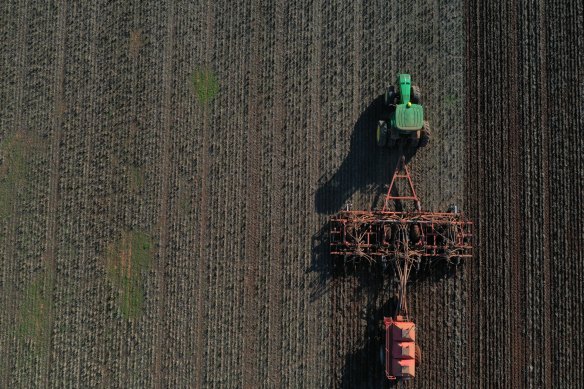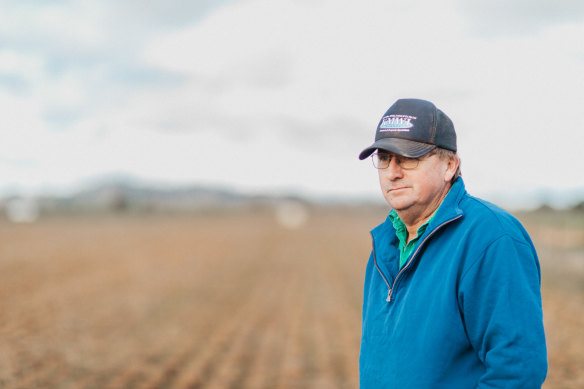Farmers ‘crippled’ by satellite failure as GPS-guided tractors grind to a halt

Save articles for later
Add articles to your saved list and come back to them any time.
Tractors have ground to a halt in paddocks across Australia and New Zealand due to a signal failure in the satellite farmers use to guide their GPS-enabled machinery, stopping them from planting their winter crop.
The satellite failure on Monday was a bolt from the blue for farmers in NSW and Victoria, who were busy taking advantage of optimal planting conditions for wheat, canola, oats, barley, legumes and other winter crops.
A tractor pulling a seeder to plant the winter crop in Balliang, Victoria. Credit: Bloomberg
“You couldn’t have picked a worse time for it,” said Justin Everitt, a grain grower in the Riverina at Brockelsby who heads up NSW Farmers grains committee.
“Over the past few years all these challenges have been thrown at us, but this is just one we never thought would come up.”
Tractors that pull seed planting machinery, as well as the massive combine harvesters that reap Australia’s vast grain crops, are high-tech beasts that can cost hundreds of thousands of dollars.
They are enabled with GPS tracking and can be guided to an accuracy within two centimetres, enabling seed planting equipment to sow crops with precision to drive up efficiency, prevent wastage and boost environmental sustainability.
But all that went out the window when the Inmarsat-41 satellite signal failed.
Katie McRobert, general manager at rural think tank the Australia Farm Institute, said Australian farmers’ source their GPS signal from the one satellite, which was a critical risk to rural industries.
“Having all your GPS eggs in one basket is a vulnerability on a good day, and a fatal weakness on a bad one,” McRobert said.
“If the Medibank and Optus data breaches didn’t make the agriculture industry sit up and take notice, the implementation of kill switches on stolen Ukrainian tractors in 2022 should have been a three-alarm wake-up call.
“Digital literacy, capability and crucially, security, need to be priority investment areas for the industry and the Australian government.”
GPS-enabled precision planting equipment has been grounded by a satellite signal failure.
Chris Groves, chairman of the National Farmers Federation farming systems committee, is planting canola, grazing wheat and oats on his property between Canowindra and Cowra in NSW.
He said the winter cropping period had kicked off with a perfectly timed autumn break, the first major rainfall event of the season that heralds the crops’ growth period, but the GPS outage would likely mean major costs and headaches for farmers.
Chris Groves said the outage is “crippling for the farm community”.Credit: Brent Young
“This is crippling for the farm community,” Groves said.
“I was talking to a cousin of mine, he has been farming for 70-odd years, and he reckons its as good an autumn break as he has ever seen,” he said.
“But GPS is our guidance system that eliminates overlapping [in rows of seeds] and over-application of chemicals, and when that system is down the machine is literally down.
“My planter is 32 rows wide, if I overlap by just two rows that is 4 per cent I am losing out on. When you’re paying $1300 [a tonne] for fertiliser that really adds up very quickly.
“My crop sprayer relies on the GPS signal to tell the spray unit how much chemical to put on, where it is in the paddock and how many nozzles it needs working.”
There is no indication when the problem will be fixed.
Satellite provider Inmarsat said a fix is under way and customers would be updated on progress.
Cut through the noise of federal politics with news, views and expert analysis from Jacqueline Maley. Subscribers can sign up to our weekly Inside Politics newsletter here.
Most Viewed in National
From our partners
Source: Read Full Article


